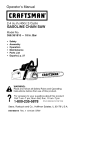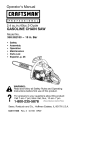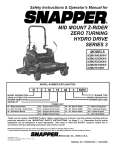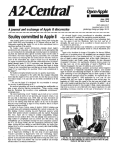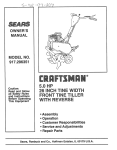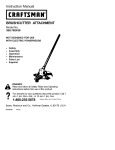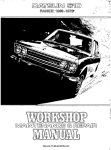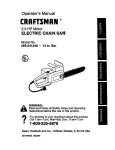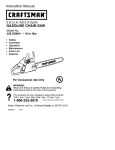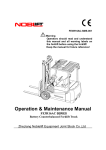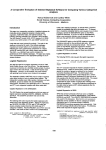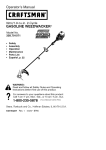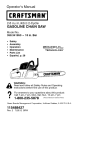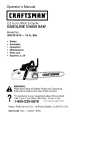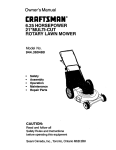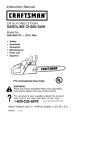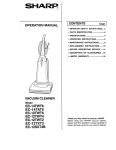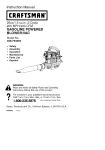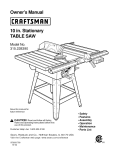Download • 1-800-235-5878
Transcript
Operator's
Manual
2,2 cu.in./36cc 2-Cycle
GASOLINE
CHAIN SAW
Model No.
358.351600
•
- 16 in. Bar
Safety
• Assembly
•
•
Operation
Maintenance
•
Parts List
•
Espar_ol,
p, 27
Read and follow all Safety Rules and Operating
WARNING:
Instructions
before first use of this product.
For
Call answers
7 am-7
•
to your
questions
this product:
pm,
Mon-Sat;
Sun,about
10 am-7
pm
1-800-235-5878
Sears, Roebuck
545186812
and Co., Hoffman
Rev, 1 6/15/08
BRW
<Hoo,olisted areCentraITime)
Estates,
IL 60179 U.S.A.
Warranty
Safety Rules
Assembly
Operation
Maintenance
Service and Adjustments
2
2
6
7
14
17
ONE YEAR FULL WARRANTY
Storage
Troubleshooting
Table
Emissions Statement
Parts List
Spanish
Parts & Ordering
20
21
23
25
27
Back Cover
ON CRAFTSMAN
When used and maintained according to the operator's manual, if this product fails
due to a defect in material or workmanship within one year from the date of purchase, return it to any Sears store, Sears Service Center, or other Craftsman outlet in
the United States for free repair (or replacement if repair proves impossible).
This warranty excludes the bar, chain, spark plug and air filter, which are expendabte parts that can wear out from normal use in less than one year.
This warranty appIies for onty 30 days from purchase date if this product is used
for commercial or rental purposes.
This warranty gives you specific legal rights, and you may atso have other rights
which vary from state to state.
Sears, Roebuck and Co., Hoffman Estates, IL 60179
• Wear protective gear. Always use
steel-toed safety footwear with non-slip
soles; snug-fitting clothing; heavy-duty,
non-slip gloves; eye protection such
as non-fogging, vented goggles or
face screen; an approved safety hard
hat; and sound barriers (ear plugs or
mufflers) to protect your hearing. Regular users should have hearing
checked regularly as chain saw noise
can damage hearing.
• Secure hair above shoulder length. Do
not wear loose clothing or jewelry; they
can get caught in moving parts.
• Keep all parts of your body away from
the chain when the engine is running.
• Keep children, bystanders, and animals a minimum of 30 feet (10 meters) away from the work area when
starting and using the saw.
• Do not handle or operate a chain
saw when you are fatigued, ill, or upset, or if you have taken alcohol,
drugs, or medication. You must be in
good physical condition and mentally
alert. If you have any condition that
might be aggravated by strenuous
work, check with doctor before operating.
• Do not start cutting until you have a
clear work area, secure footing, and,
if you are felling trees, a planned retreat path.
A4_WARNING:
Always disconnect
spark plug wire when making repairs except for carburetor adjustments. Because a chain saw is a high-speed
wood-cutting tool, speciat precautions
must be observed to reduce the risk of
accidents. Careless or improper use of
this toot can cause serious injury.
PLAN AHEAD
• Restrict the use of your saw to adult
users who understand and can follow safety rules, precautions, and
operating instructions found in this
manual
Hearing
Safety Hat
Protection _Eye
"_ I _lJ/"
Snug
Fitting -----..._
Protection
Heavy Duty
Clothing#_jGIoves
Safety
t_:_
F_:_Safety Chaps
Sh°° tl/
2
OPERATE
YOUR
SAW
SAFELY
• FoItow instructions for lubricating and
• Donotoperate
achainsawwithone changing accessories.
hand.
Serious
injury
totheoperator, • Check for damaged parts. Before furheipers,
bystanders
oranycombina- ther use of the chain saw, a guard or
tionofthese
persons
mayresult
from other part that is damaged should be
one-handed
operation.
Achain
saw
carefully checked to determine that it
isintended
fortwo-handed
use.
will operate properly and perform its
• Operate
thechainsawonlyinawelt- intended function. Check for alignment
ventilated
outdoor
area.
of moving parts, binding of moving
• Donotoperate
sawfromaladder
or
parts, breakage of parts, mounting and
inatree.
any other conditions that may affect its
• Make
surethechain
willnotmake
operation. A guard or other part that is
contact
withanyobject
while
starting damaged shouM be properly repaired
theengine.
Never
trytostartthesaw or replaced by a Sears Service Center
unless otherwise indicated elsewhere
when
theguide
barisinacut.
• Donotputpressure
onthesawat
in the operator's manual.
theendofthecut.Applying
pressure • When not in use, chain saws should
can
cause
you
to
_ose
control
when
the cut is completed.
• Stop engine before setting saw down.
• Hand carry saw only when engine is
stopped. Carry with muffler away
from body; guide bar & chain projecting behind you; guide bar preferably
covered with a scabbard.
• Do not operate a chain saw that is
damaged, improperly adjusted, or
not completely and securely assembled. Atways reptace bar, chain,
hand guard, or chain brake immediately if it becomes damaged, broken
or is otherwise removed.
MAINTAIN YOUR SAW IN GOOD
WORKING ORDER
,I_ WARNING:
Disconnect
the
spark plug before performing maintenance except carburetor adjustments.
• Have nil chain saw service performed
by a qualified service dealer with the
exception of the items listed in the
MAINTENANCE section of this manual.
• Make certain the saw chain stops
moving when the throttle trigger is
released. For correction, refer to
CARBURETOR ADJUSTMENT
• Keep the handies dry, clean, and
free from oil or fuet mixture.
• Keep caps and fasteners securely
tightened.
• Nonconforming replacement components or the removal of safety devices
may cause damage to the unit and
possible injury to the operator or bystanders. Use only Craftsman accessories and replacement parts as recommended. Never modify your saw.
• Maintain chain saw with care.
• Keep unit sharp and clean for better
and safer performance.
be stored in a dry, high or locked-up
place out of the reach of children.
• When storing saw, use a scabbard or
carrying case.
HANDLE FUEL WITH CAUTION
• Do not smoke while handling fuel or
while operating the saw.
• Eliminate att sources of sparks or
flame in the areas where fuel is
mixed or poured.
• Mix and pour fuel in an outdoor area
and use an approved, marked container for all fuet purposes. Wipe up
atl fuel splits before starting saw.
• Move at least 10 feet (3 meters) from
fueling site before starting engine.
• Turn the engine off and let saw cooI
in a non-combustible
area, not on
dry leaves, straw, paper, etc. Slowly
remove fuet cap and refuel unit.
• Empty the fuel tank before storing or
transporting the unit. Use up fueI left in
the carburetor by starting the engine
and letting it run until it stops.
• Store the unit and fuel in an area
where fuel vapors cannot reach
sparks or open flames from water
heaters, electric motors or switches,
furnaces, etc.
GUARD AGAINST KICKBACK
Follow alI safety ruIes to help avoid
kickback and other forces which can
result in serious
injury.
_ILWARNING:
Avoid kickback
which can resuIt in serious injury.
Kickback
is the backward, upward or
sudden forward motion of the guide
bar occurring when the saw chain near
the upper tip of the guide bar contacts
any object such as a log or branch, or
when the wood closes in and pinches
the saw chain in the cut. Contacting a
foreign object in the wood can also resuit in loss of chain saw control
• Rotational
Kickback
can occur
when the moving chain contacts an
object at the upper tip of the guide
bar. This contact can cause the
chain to dig into the object, which
stops the chain for an instant. The
result is a lightning fast, reverse
reaction which kicks the guide bar up
and back toward the operator.
• Pinch-Kickback
can occur when the
the wood ctoses in and pinches the
moving saw chain in the cut along
the top of the guide bar and the saw
chain is suddenly stopped. This sudden stopping of the chain results in a
reversal of the chain force used to
cut wood and causes the saw to
move in the opposite direction of the
chain rotation. The saw is driven
straight back toward the operator.
• Pull-In can occur when the moving
chain contacts a foreign object in the
wood in the cut along the bottom of
the guide bar and the saw chain is
suddenly stopped. This sudden stopping puils the saw forward and away
from the operator and could easily
cause the operator to lose control of
the saw,
REDUCE THE CHANCE OF
KICKBACK
• Recognize that kickback can happen. With a basic understanding
of
kickback, you can reduce the element of surprise which contributes to
accidents.
• Never tet the moving chain contact
any object at the tip of the guide bar.
• Keep the working area free from obstructions such as other trees,
branches, rocks, fences, stumps,
etc. Eliminate or avoid any
obstruction that your saw chain couId
hit white you are cutting.
• When cutting a branch, do not let the
guide bar contact branch or other objects around it.
• Keep saw chain sharp and properly
tensioned, A loose or dull chain can
increase the chance of kickback, Follow manufacturer's chain sharpening
and maintenance instructions. Check
tension at regular intervals, but never
with the engine running. Make sure
the bar nuts are securely tightened.
• Begin and continue cutting at futl
speed. If the chain is moving at a
slower speed, there is greater
chance of kickback occurring.
• Use extreme caution when re-entering a previous cut,
• Do not attempt cuts starting with the
tip of the bar (plunge cuts),
• Watch for shifting logs or other forces
that could close a cut and pinch or
fail into chain,
• Use the Reduced-Kickback
Guide
Bar and Low-Kickback
Chain specified for your saw,
Avoid Pinch-Kickback:
• Be extremely aware of situations or
obstructions that can cause material
to pinch the top of or otherwise stop
the chain.
• Do not cut more than one log at a
time.
• Do not twist the saw as the bar is
withdrawn from an undercut when
bucking.
Avoid Putl-ln:
• Always begin cutting with the engine
at full speed and the saw housing
against wood.
• Use wedges made of ptastic or wood.
Never use metal to ho_d the cut open.
MAINTAIN CONTROL
Stand to the left of the saw
Thumb on
h O,s,de ",{
Never reverse hand positions
• A good, firm grip on the saw with both
hands will heIp you maintain control.
Don't let go. Grip the rear handle with
your right hand whether you are right
or left handed. Wrap the fingers of
your left hand over and around the
front handlebar, and your teft thumb
under the front handlebar. Keep your
ieff arm straight with the elbow locked,
Low-Kickback Chain
• Position
yourlefthand
onthefront
Contoured Depth Gauge
handtebar
soitisinastraight
tine
withyourrighthandontherear
deflects kickback
handle
whenmaking
bucking
cuts.
force And allows
Never
reverse
rightandlefthand
_._
longated
Guard Link
wood
to gradually
positions
foranytypeofcutting.
ride into Cutter
• Stand
withyourweight
evenly
bal- CHAIN BRAKE
anced
onbothfeet.
• Chain Brake, designed to stop the
• Donotoverreach.
Youcouid
be
drawn
orthrown
offbalance
andlose chain in the event of kickback.
control
ofthesaw.
WE DO NOT REP• Donotcutabove
shoulder
height,
tt _0&WARNING:
AND YOU SHOULD NOT ASisdifficuIt
tomaintain
control
ofsaw RESENT
SUME THAT THE CHAIN BRAKE WILL
above
shoulder
height.
KICKBACK
SAFETY
FEATURES PROTECT YOU IN THE EVENT OF A KICKBACK Kickback is a lightning fast action
WARNING:
Thefollowing
feawhich throws the bar and rotating chain
tures
areincluded
onyoursawtohelp back and up toward the operator. Kickreduce
thehazard
ofkickback;
however,back can be caused by aIIowing contact
such
features
witlnottotaity
eliminate of the bar tip in the danger zone with
thisdanger.
Donotretyonlyonsafety any hard object. Kickback can also be
devices.
Foltow
atlsafety
rules
tohetp caused by pinching the saw chain along
avoid
kickback
andother
forces
which the top of the guide bar. This action may
push the guide bar rapidly back toward
canresult
inserious
injury.
• Front
Hand
Guard,
designed
toreduce the operator. Either of these events may
thechance
ofyourlefthand
contact- cause you to lose control of the saw
ingthechain
ifyourhand
slipsoffthe which could result in serious injury or
front
handlebar.
even death. DO NOT RELY UPON ANY OF
• Position
offront
andrearhandlebars,THE DEVICES BUILT iNTO YOUR SAW.
designed
withdistance
between
han- YOU SHOULD USE THE SAW PROPERLY
dlesand"in-line" with each other. The
AND CAREFULLY TO AVOID KICKBACK.
spread and "in-line" position of the
hands provided by this design work
together to give balance and resistance in controlling the pivot of the
saw back toward the operator if kickback occurs.
• Reduced-Kickback
Guide Bar, designed with a smatl radius tip which
reduces the size of the kickback
danger zone on the bar tip. This type
of bar has been demonstrated to significantly reduce the number and seriousness of kickbacks when tested
in accordance with ANSI B175.1.
Tip Guide Bar
_&
SmaII Radius
Large Radius
Tip Guide Bar
_
"_
• Low-Kickback
Chain, has met kickback performance requirements
when tested on a representative
sampie of chain saws below 3.8 cubic inch displacement
specified in
ANSi B175.1.
Reduced-kickback
guide bars and Jowkickback saw chains reduce the chance
and magnitude of kickback and are recommended. Your saw has a tow kickback chain and bar as original equipment. Repairs on a chain brake should
be made by an authorized Sears Service Center. Take your unit to the place
of purchase if purchased from a servicing dealer, or to your nearest Sears Service Center
• Tip contact in some cases may cause
a Iightning fast reverse REACTION,
kicking guide bar up and back toward
operator.
• Pinching the saw chain along the top
of the guide bar may push the guide
bar rapidly back toward the operator.
• Either of these reactions may cause
you to lose control of the saw which
could result in serious injury. Do not
rely exclusively upon devices built into
your
SaW.
This unit is not equipped with an antivibration system and is intended for
occasional use only.
SAFETY NOTICE: Exposure to vibrations through prolonged use of gasoline
powered hand tools could cause blood
vessel or nerve damage in the fingers,
hands, and joints of people prone to
circulation disorders or abnormal swellings. Prolonged use in cold weather has
been linked to blood vessel damage in
otherwise healthy people. If symptoms
occur such as numbness, pain, loss of
strength, change in skin color or texture,
or toss of feeling in the fingers, hands, or
joints, discontinue tile use of this toot
and seek medical attention. An anti-vibration system does not guarantee the
avoidance of these problems. Users
who operate power tools on a continual
and regular basis must monitor closely
their physical condition and the condition
of this tool.
CHAIN BRAKE: If this saw is to be
used for commercial logging, a chain
brake is required and shall not be removed or otherwise disabled to compty with Federal OSHA Regutations
Commercial
Logging.
£..
,_WARNING:
saw,
ensure
are
secure,
CARTON CONTENTS
Check carton contents against the following list.
Model 358.351600
•
•
•
•
the Customer Responsibilities
the MAINTENANCE section.
STANDARDS:
chart in
This chain saw is tisted
by Underwriters Laboratories, Inc. in accordance with American National Standards for Gasoline-Powered Chain
Saws Safety Requirements (ANSI
B175,1-2000).
for
Before using chain
a_t fasteners
SPARK ARRESTING
SCREEN: Your
saw is equipped with a temperature
limiting muffler and spark arresting
screen which meets the requirements
of California Codes 4442 and 4443.
All U.S, forest land and the states of
Catifornia, Idaho, Maine, Minnesota,
New Jersey, Oregon, and Washington
require by law that many internal combustion engines to be equipped with a
spark arresting screen. If you operate
a chain saw in a state or locale where
such regulations exist, you are legally
responsible for maintaining the operating condition of these parts. Failure to
do so is a violation of the law. Refer to
Chain saw (fully assembled)
Chain adjustment tool (bar tool)
2-cycle engine oil
Carrying case
Examine parts for damage. Do not use
damaged parts.
tf you need assistance or find that parts
are missing or damaged, please caIt
1-800-235-5878.
NOTE: tt is normal to hear the fuel filter
rattle in an empty fuel tank.
Your unit has been factory tested and
the carburetor precisely adjusted. As a
result you may smelt gasoline or find a
drop of oil/fuet residue on the mL_er
when you unpack the unit.
ASSEMBLY
Your saw is fully assembled;
assembly is necessary.
no
KNOW YOUR
CHAIN
SAW
READ THIS OPERATOR'S
MANUALAND
CHAIN SAW. Compare
Iocation
of the various
erence,
SAFETY
RULES BEFORE
the illustrations
with your
controts
and adjustments.
OPERATING
Front Hand Guard _.
Front Starter
Handle Rope
ON/STOP
Switch
Chain
YOUR
unit to familiarize
yourself
with the
Save this manual
for future ref-
Muffler
Choke!
Lever
b
Bar
Sprocket
Hole
Bar Oil Fill Cap
Starter Housing
Fuel Mix Fitl Cap
Primer Bulb
Cylinder Cover
Throttle
Lockout
Chain
Chain
Direction
of Travel
Rear
Handle
CRt:iFTSMRN°
Guide Bar
Throttle
Trigger
Ctutch Cover
Catcher
Bar Nuts
CHAIN BRAKE
The CHAIN BRAKE is a device designed
to stop the chain if kickback occurs. The
chain brake activates automatically in
the event of kickback. The chain brake
activates manually if the front hand
guard is pushed forward. The chain
brake is disengaged by pulling the front
hand guard back toward the front handle
as far as possible.
CHAIN TENSION
It is normaI for a new chain to stretch
during the first 15 minutes of operation.
You should check your chain tension
each time before you start the chain
saw. See CHAIN TENSION under the
MAINTENANCE section.
ON/STOP SWITCH
The ON/STOP SWITCH is used to stop
the engine.
THRO'N'LE TRIGGER
The THRO_LE TRIGGER controls engine speed.
THROTI'LE LOCK-OUT
The THRO_LE LOCK-OUT must be
pressed before you can squeeze the
throttle trigger. This feature prevents you
from accidentally squeezing the trigger.
CHOKE/FAST IDLE LEVER
The choke and fast idle are set by pulling the CHOKE/FAST iDLE LEVER out to
the full extent for cold starting or after
refueling. The choke provides additional
fuel to the engine during cold starting.
PRIMER BULB
The PRIMER BULB circulates fue_ to the
carburetor to provide quicker starting.
,_WARNING:
Ifthe saw is operated with a loose chain, the chain
could jump off the guide bar and result
in serious injury to the operator and/or
damage the chain making it unusable.
7
BEFORE
STARTING
ENGINE
_ll, WARNING:
Muffter is very hot
during and after use. Do not touch the
muffIer or allow combustible material
such as dry grass or fuel to do so.
_LWARNING:
Be sure to read the
fuel handling information in the safety
rules section of this manual before you
begin, tf you do not understand the
fuel handling information do not attempt to fuel your unit. Seek help from
someone that does understand the information or can the customer assistance help line at 1-800-235-5878.
GUIDE BAR AND CHAIN OIL
The bar and chain require lubrication.
The chain oiler provides continuous
Iubrication to the chain and guide bar.
Be sure to fiIt the bar oil tank when you
fill the fueI tank (Capacity = 6.8 ft. oz.).
Lack of oil win quickly ruin the bar and
chain. Too little oil will cause overheating shown by smoke coming from the
chain and/or discoloration of the bar.
For maximum guide bar and chain life,
we recommend you use Craftsman
chain saw bar oil. If Craftsman bar oit
is not available, you may use a good
grade SAE 30 oiI until you are aMe to
obtain Craftsman brand. The oil output
is automatically metered during operation. Your saw will use approximately
one tank of bar oil for every tank of fuel
mix. Atways fill the bar oil tank when
you fill the fuet tank.
FUELING ENGINE
_WARNING:
Remove fuel cap
slowly when refueling.
This engine is certified to operate on
unteaded gasoline. Before operation,
gasotine must be mixed with a good
quatity synthetic 2-cycIe air-cooIed engine oil. We recommend Craftsman
brand synthetic oil. Mix gasoline and
oit at a ratio of 40:1. A 40:1 ratio is obtained by mixing 3.2 ounces of oil with
1 gailon of unleaded gasoline. Included
with this saw is a 3.2 ounce container of
oil Pour the entire contents of this container into 1 gallon of gasoline to
achieve the proper fuel mixture.
DO NOT USE automotive or boat oil
These oils wiit cause engine damage.
When mixing fuel fottow the instructions printed on the oil container. Once
oil is added to the gasoline, shake
container momentarily to assure that
the fuet is thoroughly mixed. Always
read and follow the safety rules relating to fueI before fueling your unit.
IMPORTANT
Experience indicates that alcoholblended fueis (called gasohol or using
ethanot or methanol) can attract moisture which leads to separation and
formation of acids during storage. Acidic
gas can damage the fuel system of an
engine while in storage. To avoid engine
problems, the fuel system should be
emptied before storage for 30 days or
longer. Drain the gas tank, start the engine and let it run until the fuel lines and
carburetor are empty. Use fresh fuel
next season. Never use engine or carburetor cteaner products in the fuel tank
or permanent damage may occur,
See the STORAGE section for additionai
information
CHAIN BRAKE
Ensure chain brake is disengaged by
pulling the front hand guard back toward
the front handle as far as possible. The
chain brake must be disengaged before
cutting with the saw.
_
WARNING:
The chain must not
move when the engine runs at idle
speed. If the chain moves at idle
speed refer to CARBURETOR ADJUSTMENT within this manual. Avoid contact
with the muffler. A hot muffler can
cause serious burns.
STOPPING YOUR ENGINE
• Release the throttle trigger.
• Move ON/STOP switch to the STOP
position.
STARTING POSITION
• To start the engine, hold the saw
firmly on the ground as iitustrated.
Make sure the chain is free to turn
without contacting any object.
Starter Rope Handle
Left Hand
on Front
Handle
Right Foot Through
Rear Handle
CHOKE/FAST
_ILWARNING:
Do not attempt to
throw or drop-start the chain saw,
Doing so witt put the operator at risk of
serious injury due to loss of controI of
the chain saw.
IMPORTANT POINTS TO REMEMBER
When puIIing the starter rope, do not
use the full extent of the rope as this
can cause the rope to break. Do not let
starter rope snap back. HoM the handle and let the rope rewind stowty.
For cold weather starting, start the unit
at FULL CHOKE; allow the engine to
warm up before squeezing the throttle
trigger.
NOTE: Do not attempt to cut material
with the choke/fast idle lever in the FULL
CHOKE position.
STARTING A COLD ENGINE (or warm
engine after running out of fuel)
NOTE: tn the following steps, when the
choke/fast idle lever is pulled out to the
fult extent, the correct throttte setting for
starting is set automatically,
IGNITION
SWITCH
ON
Lever
1.
Move ON/STOP switch to the ON
position.
2. Pult choke/fast idle lever out to the
full extent (to the FULL CHOKE position).
3. Slowly press primer bulb 6 times.
4. Putt the starter rope sharply 5 times
with your right hand. Then, proceed to the next step.
NOTE: If the engine sounds as if it is trying to start before the 5th pull, stop pulling and immediately proceed to the next
step.
5. Push the choke/fast idle lever in to
the HALF CHOKE position.
oil
IDLE LEVER
iF HALF
ITm . / FULL
6.
Putt the starter rope sharply with
your right hand until the engine
starts.
7, Allow the engine to run for approximately 30 seconds. Then, squeeze
and release the throttle trigger to
allow engine to return to idle
speed.
STARTING A WARM ENGINE
1. Move ON/STOP switch to the ON
position.
2. Putt the choke/fast idle lever out to
the FULL CHOKE position to set the
fast idle, then push the lever in to
the HALF CHOKE position.
3. Stowly press primer bulb 6 times.
4. Putt the starter rope sharply with
your right hand untit the engine
starts.
5. Squeeze and release throttle trigger
to allow engine to return to idle
speed.
DIFFICULT STARTING (or 8tatting a
flooded engine)
The engine may be flooded with too
much fuet if it has not started after 10
pulls.
Flooded engines can be cleared of excess fuel by pushing the choke/fast
idle lever in completeIy (to the OFF
CHOKE position) and then following the
warm engine starting procedure listed
above. Ensure the ON/STOP switch is
in the ON position,
Starting could require pulling the starter rope handle many times depending
on how badly the unit is flooded, If engine fails to start, refer to the TROUBLESHOOTING TABLE or call
1-800-235-5878.
CHAIN
BRAKE
_b'WARNING:
If the brake band is
worn too thin it may break when the
chain brake is triggered. With a broken
brake band, the chain brake will not
stop the chain. The chain brake must
be replaced if any part is worn to tess
than 0.020" (0.5 ram) thick. Repairs on
a chain brake should be made by your
Sears Service Center. Take your unit
to the piace of purchase or to the nearest Sears Service Center.
• This saw is equipped with a chain
brake. The brake is designed to stop
the chain if kickback occurs.
• The inertia-activated
chain brake is
activated if the front hand guard is
pushed forward, either manually (by
hand) or automatically (by sudden
movement).
• If the brake is already activated, it is
disengaged by puiting the front hand
guard back toward the front handle
as far as possible.
• When cutting with the saw, the chain
brake must be disengaged.
Braking function control
CAUTION:
The chain brake must be
checked several times daily. The engine must be running when performing
this procedure.
This is the onIy
instance when the saw shouid be
placed on the ground with the engine
running.
Place the saw on firm ground. Grip the
rear handle with your right hand and
the front handle with your left hand.
Apply futt throttle by fully depressing
the throttle trigger. Activate the chain
brake by turning your left wrist against
the hand guard without releasing your
grip around the front handle. The chain
shoutd stop immediately.
Inertia
activating
_kWARNING:
function
control
When performing
the foitowing procedure, the engine
must be turned off.
Grip the rear handte with your right hand
and the front handle with your teft hand.
Hotd the chain saw approximately 14
inches (35 cm) above a stump or other
wooden surface. Reiease your grip on
the front handle and use the weight of
the saw to let the top of the guide bar
fall forward and contact the stump.
When the tip of the bar hits the stump,
the brake should activate.
OPERATING TIPS
• Check chain tension before first use
and after 1 minute of operation, and
each time before you start the chain
saw. See CHAIN TENSION in the
MAINTENANCE section.
• Cut wood only. Do not cut metaI, plastics, masonry, non-wood building materials, etc.
• Stop the saw if the chain strikes a
foreign object. Inspect the saw and
repair or replace parts as necessary.
If the chain jumps off the guide bar,
inspect the chain for damaged drive
links before reinstalling. Burrs on
drive links, which prevent them from
entering the groove of the guide bar,
can be removed with a flat rite.
• Keep the chain out of dirt and sand.
Even a smaII amount of dirt will dull a
chain, increase the possibility of kickback, and require chain sharpening or
replacement.
• Practice cutting a few small logs using the following techniques to get
the "feeF of using your saw before
you begin a major sawing operation.
• Squeeze the throttIe trigger and allow
the engine to reach full speed before
cutting.
• Begin cutting with the saw frame
against the log.
• Keep the engine at full speed the
entire time you are cutting.
• Altow the chain to cut for you. Exert
onty tight downward
pressure,
tf
you force the cut, damage to the
bar, chain, or engine can result.
• Release the throttle trigger as soon
as the cut is completed, allowing
the engine to idle. Ifyou run the saw
at full throttle without a cutting toad,
unnecessary wear can occur to the
chain, bar, and engine. To maximize operating efficiency, do not
run the engine for longer than 30
_econd_ at a time at full throttle.
• To avoid losing control when cut is
complete, do not put pressure on
saw at end of cut.
• Stop the engine before setting the
saw down after cutting.
10
TREE FELLING
TECHNIQUES
_II, WARNING:
Check for broken or
dead branches which can fall while cutting causing serious injury. Do not cut
near buildings or electrical wires if you
do not know the direction of tree falt, nor
cut at night since you will not be aIe to
see well, nor during bad weather such
as rain, snow, or strong winds, etc. tf
the tree makes contact with any utility
Iine, the utility company should be notified immediately.
• Carefuily plan your sawing operation
in advance.
• Ctear the work area. You need a ciear
area nil around the tree so you can
have secure footing.
• The chain saw operator shoutd keep
on the uphill side of the terrain as the
tree is likely to roll or slide downhill
after it is felled.
• Study the natural conditions that can
cause the tree to fall in a particular direction.
Natural conditions that can cause a tree
to fail in a particular direction include:
• The wind direction and speed.
• The lean of the tree. The tean of a
tree might not be apparent due to uneven or sloping terrain. Use a piumb
or level to determine the direction of
tree lean.
• Weight and branches on one side.
• Surrounding trees and obstactes.
Look for decay and rot. If the trunk is
rotted, it can snap and fall toward the
operator. Check for broken or dead
branches which can fall on you while
cutting. Make sure there is enough
room for the tree to fail Maintain a distance of 2 _/2tree lengths from the nearest person or other objects. Engine
noise can drown out a warning call.
Remove dirt, stones, loose bark, naiis,
staples, and wire from the tree where
cuts are to be made.
Plan a ctear retreat path to the rear
and diagonal to the line of fail
_
"_ -- = O
FELLING LARGE TREES
(6 inches (15 cm) in diameter or larger)
The notch method is used to fell large
trees. A notch is cut on the side of the
tree in the desired direction of fall. After
a felling cut is made on the opposite
side of tree, the tree wiII tend to fail into
the notch.
NOTE: If the tree has large buttress
roots, remove them before making the
notch. If using saw to remove buttress
roots, keep saw chain from contacting
ground to prevent dulling of the chain.
NOTCH CUT AND FELLING THE
TREE
• Make notch cut by cutting the top of
the notch first. Cut through 1/3of the
diameter of the tree. Next compiete
the notch by cutting the bottom of the
notch. See iiiustration. Once the
notch is cut remove the notch of
wood from the tree.
Final (felting) cut here, 2 inches
(5 cm) above center of notch
i'
Notch _
_t
_.j..
=
• After removing the wood from the
notch, make the felling cut on the opposite side of the notch. This is done
by making a cut about two inches (5
cm) higher than the center of the
notch. This witt leave enough uncut
wood between the felling cut and the
notch to form a hinge. This hinge wili
help prevent the tree from faliing in the
wrong direction.
Hinge holds tree on stump and helps
control fall
Opening
of felling
Plan a clear retreat path
"_
- Direction of Fal_
Closing of
notch
NOTE: Before felling cut is complete,
use wedges to open the cut if necessary
to control the direction of fall. To avoid
11
kickback and chain damage, use wood
or p}astic wedges, but never steel or iron
wedges.
• Be alert to signs that the tree is
ready to fail: cracking sounds, widening of the feI}ing cut, or movement in
the upper branches.
• As tree starts to fall stop saw, put it
down, and get away quickly on your
ptanned retreat path.
• DO NOT cut down a partially fatten tree
with your saw. Be extremely cautious
with partially fallen trees that may be
poody supported. When a tree doesn't
falI comptetely, set the saw aside and
pul} down the tree with a cable winch,
bIock and tackle, or tractor.
CUTTING A FALLEN TREE
(BUCKING)
Bucking is the term used for cutting a
fallen tree to the desired tog size.
dab WARNING:
Do not stand on the
tog being cut. Any portion can rott
causing toss of footing and control, Do
not stand downhill of the log being cut.
IMPORTANT
POINTS
• Cut on}y one tog at a time.
• Cut shattered wood very carefully;
sharp pieces of wood could be f_ung
toward operator.
• Use a sawhorse to cut small logs.
Never allow another person to hold
the Iog white cutting and never hold
the Iog with your teg or foot.
• Do not cut in an area where _ogs,
timbs, and roots are tangled such as
in a blown down area. Drag the togs
into a ctear area before cutting by
putHng out exposed and cIeared togs
first.
TYPES OF CUTTING
BUCKING
_WARNING:
Use a wedge
to remove
pinched
saw
Turn saw OFF and use a plastic or
wooden wedge to force cut open.
Overcutting begins on the top side of
the log with the bottom of the saw
against the _og. When overcutting use
light downward pressure,
,
_fvercutting
J_
:9
Undercutting
"" _,
Undercutting
involves cutting on the
underside of the log with top of saw
against the _og. When undercutting
use light upward pressure. Hotd saw
firmty and maintain control. The saw
wiI_tend to push back toward you.
A_ILWARNING:
Never turn saw upside down to undercut. The saw cannot be controlled in this position.
Always make your first cut on the compression side ofthe Iog. The compression side of the tog is where the pressure of the log's weight is
concentrated.
_rst
cut
Second
On compression
side
of log
cut
Second cut
USED FOR
If saw becomes
pinched or hung in a log, don't try to
force it out. You can tose control of the
saw resulting in injury and/or damage
to the saw. Stop the saw, drive a
wedge of plastic or wood into the cut
until the saw can be removed easily.
Restart the saw and carefully reenter
the cut. To avoid kickback and chain
damage, do not use a metal wedge.
Do not attempt to restart your saw
when it is pinched or hung in a log.
First cut on compression side of log
BUCKING WITHOUT A SUPPORT
• Overcut through 1/3 of the diameter
of the log.
• Roll the Iog over and finish with a
second overcut.
• Watch for togs with a compression
side to prevent the saw from pinching. See ittustrations for cutting togs
with a compression side.
BUCKING USING A LOG OR
SUPPORT STAND
• Remember your first cut is a_ways on
the compression side of the log.
(Refer to the illustrations below for
your first and second cut)
12
• Your first cut should extend 1/3 of the
diameter of the log.
• Finish with your second cut.
Using a log for support
f/1
stCut
Using a support stand
2 nd Cut
X
• Watch out for springpotes, SpringpoIes
are smalt size limbs which can catch
the saw chain and whip toward you or
pull you off balance. Use extreme caution when cutting small size limbs or
slender material,
• Be alert for springback. Watch out for
branches that are bent or under
pressure, Avoid being struck by the
branch or the saw when the tension
in the wood fibers is released.
• Keep a clear work area. Frequently
clear branches out of the way to avoid
tripping over them.
LIMBING
• Always timb a tree after it is cut
down. Only then can limbing be done
safely and properly.
• Leave the larger limbs underneath the
felled tree to support the tree as you
work.
• Start at the base of the felled tree and
work toward the top, cutting branches
and limbs. Remove smaII limbs with
one cut.
• Keep the tree between you and the
chain. Cut from the side of the tree
opposite the branch you are cutting.
• Remove larger, supporting branches
with the cutting techniques described
in BUCKING WITHOUT A SUPPORT.
• Always use an overcut to cut smalI
and freely hanging limbs, Undercutting
could cause limbs to fail and pinch the
SaW.
L
LIMBING
PRUNING
AND PRUNING
_IIWARNING:
Be alert for and
guard against kickback. Do not allow the
moving chain to contact any other
branches or objects at the nose of the
guide bar when limbing or pruning. Allowing such contact can result in serious
injury.
_iI_WARNING:
_I'WARNING:
Limit pruning to limbs
shoulder height or below. Do not cut if
branches are higher than your shoulder,
Get a professional to do the job.
• Make your first cut 1/3of the way
through the bottom of the limb.
• Next make a 2nd cut all the way
through the limb. Then cut a third
overcut leaving a 1 to 2 inch (2,5 to 5
cm) collar from the truck of the tree,
I
,I sooondout
"//
i •
,_r_"
•
Never climb into a
tree to limb or prune.
ladders, platforms, a
tion which can cause
balance or control of
Do not stand on
log, or in any posiyou to lose your
the saw.
Third ctt_/
Col,at
_
IMPORTANT
POINTS
• Work slowly, keeping both hands firmty
gripped on the saw. Maintain secure
footing and balance.
/
13
First cut
Pruning technique
CUSTOMER
RESPONSIBILITIES
_WARNING:
Disconnect the spark plug before
except for carburetor adjustments.
Filt in dates as you complete
regular service
Check for damaged/worn
Before
Use
parts
After
Use
performing
Ever
5 hrs
maintenance
Every
25 hrs. Yearly
Service
Dates
.,I
Check for loose fasteners/parts
Check chain tension
i_"
Check chain sharpness
_'
Check guide bar
_'
Check fuel mixture
leveI
Check guide bar and chain oit
_'
_'_
Inspect and ctean unit &decaIs
_"
Check chain brake
/I
CIean guide bar groove
Clean air filter
/-"
C_ean/inspect muffler and spark
arresting screen
Replace
_'_
spark plug and fueI filter
GENERAL RECOMMENDATIONS
The warranty on this unit does not cover items that have been subjected to
operator abuse or negligence. To receive futt vatue from the warranty, the
operator must maintain unit as
instructed in this manual, Various adjustments wilt need to be made periodicaHy to propedy maintain your unit.
• Once a year, replace the spark plug,
air fitter, and check guide bar and
chain for wear. A new spark plug and
air fitter assures proper air-fuet mixture
and helps your engine run better and
last Ionger.
CHECK FOR DAMAGED
OR
WORN PARTS
Contact your Sears Service Center for
reptacement of damaged or worn parts.
NOTE: It is normal for a smalI amount of
oit to appear under the saw after engine
stops. Do not confuse this with a teaking
oil tank.
• ON/STOP Switch - Ensure ON/STOP
switch functions properly by moving
the switch to the STOP position. Make
sure engine stops; then restart engine
and continue.
• FueI Tank - Do not use saw if fuel
tank shows signs of damage or leaks.
_• Oil Tank - Do not use saw if oil tank
shows signs of damage or leaks.
CHECK FOR LOOSE
FASTENERS AND PARTS
• Bar Nuts
• Chain
• Muffler
• Cylinder Shield
• Air Filter
• Handle Screws
• Vibration Mounts
• Star_er Housing
• Front Hand Guard
CHECK
CHAIN TENSION
A_ILWARNING:
Wear protective
gloves when handling chain. The chain
is sharp and can cut you even when it is
not moving.
Chain tension is very important. Chains
stretch during use. This is especially true
during the first few times you use your
saw. Atways check chain tension each
time before you start the chain saw.
1. Use the screwdriver end of the
chain adjustment tool (bar tooI) to
move chain around guide bar to
ensure kinks do not exist. The
chain should rotate freely.
14
Guide
Bar
_J
Bar Nuts Adjusting
Screw
2.
3.
4.
5.
6.
Chain Adjustment
Too_
(Bar Tool)
Loosen bar nuts until they are
finger tight against the clutch cover.
Turn adjusting screw clockwise until chain solidly contacts bottom of
guide bar rail.
Using bar tool, roll chain around
guide bar to ensure all links are in
bar groove.
Lift up tip of guide bar to check for
sag. Release tip of guide bar, then
turn adjusting screw until sag does
not exist.
White lifting tip of guide bar, tighten
bar nuts securely with the bar toot.
off the guide bar and result in serious
injury to the operator and/or damage the
chain making it unusable. If the chain
jumps off the guide bar, inspect each
drive link for damage, Damaged chain
must be repaired or replaced.
CHECK CHAIN SHARPNESS
A sharp chain makes wood chips. A dull
chain makes a sawdust powder and
cuts slowly. See CHAIN SHARPENING.
CHECK GUIDE BAR
Conditions which require guide bar
maintenance:
• Saw cuts to one side or at an angle.
• Saw has to be forced through the cut.
• Inadequate supply of oit to bar/chain.
Check the condition of guide bar each
time chain is sharpened. A worn guide
bar will damage the chain and make
cutting difficult.
After each use, ensure ON/STOP
switch is in the STOP position, then
clean all sawdust from the guide bar
and sprocket hote.
To maintain guide bar:
• Move ON/STOP switch to STOP.
• Loosen and remove bar nuts and
clutch cover. Remove bar and chain
from saw.
• Clean the oit holes and bar groove
after each 5 hours of operation.
Bar Nuts
Oil Holes
7.
8.
9.
Use the screwdriver end of the bar
tool to move chain around guide
bar.
If chain does not rotate, it is too
tight. Slightly loosen bar nuts and
loosen chain by turning the adjusting screw 1/4 turn counterclockwise. Retighten bar nuts.
tf chain is too loose, it will sag below the guide bar. DO NOT operate
the saw if the chain is loose.
NOTE: The chain is tensioned correctly
when the weight of the chain does not
cause it to sag below the guide bar
(with the chain saw sitting in an upright
position), but the chain still moves freely
around the guide bar.
,AWARNING:
If the saw is operated
with a loose chain, the chain could jump
• Burring of guide bar raiIs is a normal
process of rail wear. Remove these
burrs with a flat file.
• When rail top is uneven, use a flat
file to restore square edges and
sides,
7_
Worn Groove
and Sides
File Square
Rail Edges _
[U]
Correct Groove
Replace guide bar when the groove is
worn, the guide bar is bent or cracked,
or when excess heating or burring of the
rails occurs, If replacement is necessary,
use onty the guide bar specified for your
saw in the repair parts list or on the decat located on the chain saw.
CHECK FUEL MIXTURE LEVEL
• See FUELING ENGINE under the OPERATION section.
15
LUBRICATION
Cytinder
Cover
Air Filter
Cover*
BarOil
FillCa
• See GUIDE BAR AND CHAIN OIL under the OPERATION section.
INSPECT AND CLEAN UNIT AND
DECALS
• After each use, inspect compiete unit
for loose or damaged parts. Clean the
unit and decals using a damp cloth
with a mild detergent.
• Wipe off unit with a clean dry cloth.
CHECK CHAIN BRAKE
See CHAIN BRAKE in the OPERATiON section.
CLEAN AIR FILTER
CAUTION:
Do not clean filter in gasoiine or other flammable solvent to
avoid creating a fire hazard or producing harmful evaporative emissions.
Cleaning the air filter:
A dirty air filter decreases the life and
performance of the engine and increases fuel consumption and harmfut
emissions. Always clean your air fitter
after 10 tanks of fuet or 5 hours of operation, whichever comes first. Ctean
more frequently in dusty conditions. A
used air filter can never be completely
cleaned. It is advisable to replace your
air filter with a new one after every 50
hours of operation, or annually, whichever comes first.
1.
2.
3.
4.
5.
6.
Loosen 3 screws on cytinder cover.
Remove cylinder cover.
Remove air fitter cover and air filter.
Clean the air filter using hot soapy
water. Rinse with clean cool water.
Air dry completely before reinstalling.
Reinstall air fitter and air filter cover.
Reinstalt cylinder cover and 3
screws. Tighten securely.
INSPECT MUFFLER AND SPARK
ARRESTING SCREEN
_WARNING:
The muffler on this
product contains chemicals known to
the State of California to cause cancer.
As the unit is used, carbon deposits
build up on the muffler and spark arresting screen, and must be removed
to avoid creating a fire hazard or affecting engine performance.
RepIace the spark arresting screen if
breaks occur.
Spark
Arresting
Screen
Exhaust
Out{et
Cover
Nut
Muffler
CLEANING THE SPARK ARRESTING SCREEN
Cleaning is required every 25 hours of
operation or annually, whichever
comes first.
1. Loosen and remove the nut from
the exhaust outiet cover.
2. Remove the exhaust outet cover.
3.
4.
5.
6,
16
Remove spark arresting screen.
Handle screen carefuliy to prevent
damage.
Clean the spark arresting screen
gently with a wire brush. Replace
screen if breaks are found.
Replace any broken or cracked
muffler parts.
Reinstati spark arresting screen, exhaust outlet cover, and nut. Tighten
nut securely.
REPLACE SPARK PLUG
The spark plug should be replaced
each year to ensure the engine starts
easier and runs better. Ignition timing
is fixed and nonadjustable.
1. Loosen 3 screws on cylinder cover.
2. Remove the cylinder cover.
3. Pull off the spark plug boot.
4. Remove spark plug from cylinder
and discard.
5. Replace with Champion RCJ-7Y
spark plug and tighten securely
with a 3/4 inch (19 mm) socket
wrench. Spark plug gap should be
0.025 inch (0,6 mm).
5. Reinstall the spark plug boot.
7. Reinstall the cytinder cover and 3
screws. Tighten securely.
_
WARNING:
Disconnect
the
spark plug before performing maintenance, service, or adjustments except
for carburetor adjustments.
CHAIN SHARPENING
_WARNING:
Improper chain
sharpening techniques and/or depth
gauge maintenance wili increase the
chance of kickback which can result in
serious injury,
_lJ WARNING:
Cylinder
Cover
Spark
Plug Boot
Spark
Plug
REPLACE FUEL FILTER
To replace fuel filter, drain your unit by
running it dry of fuel. Remove fuel cap
and its connected retainer from tank.
Putt filter from tank and remove from
line. Replace and reassemble.
TO SHARPEN CHAIN:
1. Move ON/STOP switch to the STOP
position.
2. Check chain for proper tension.
Adjust chain tension if necessary.
See CHAIN TENSION section.
3.
Wear protective
gloves when handling chain. The chain
is sharp and can cut you even when it is
not moving.
Conditions which indicate the need for
chain sharpening:
• Reduction in size of wood chips. The
size of the wood chip wilt decrease
as the chain gets duller until it becomes more like a powder than a
chip. Note that dead or rotted wood
will not produce a good chip.
• Saw cuts to one side or at an angle.
• Saw has to be forced through the cut.
Tool8 required:
• 5/32 inch (4 mm) diameter round file
and file holder
• Flat file
• Depth gauge tool
Sharpen cutters.
• To sharpen the cutters, position
the file holder level (90 °) so that it
rests on the top edges of the cutter and depth gauge.
NOTE:
The chain has both left
and right hand cutters.
File Hod_e_/ File_
Cutely
I_Y
DepthGauge r
•
Align the 30 ° file holder marks
parattet with the bar and to the
center of the chain.
Cutter
30 °
File Holder Line
•
17
Sharpen cutters on one side of the
chain first, File from the inside of
each cutter to the outside. Then,
turn the chain saw around and repeat the process for the other side
of the chain.
• File on the forward stroke only.
use 2 or 3 strokes per cutting
edge.
• Keep all cutters the same length
when filing.
• File enough to remove any damage to cutting edges (side plate
and top plate of cutter).
All Cutters
Remove Damage
Same Length
_/
NOTE: The very top of the
depth gauge should be flat with
the front hatf rounded off with a
flat file.
tf you require further assistance or are
unsure about performing this procedure,
contact your Sears Service Center or
catI our customer assistance help line at
1-800-235-5878.
•
during the first 15 minutes of operation.
You should recheck your chain tension
each time before you start the chain saw
and adjust the chain tension as required.
See CHAIN TENSION section.
File chain to meet the specifications as shown.
/_,.
b- 85°
_
o
".60
/
30 °'
Hook Angle
k_
Right
Too Much Hook Angle
0025 inch
Corner
Squared Off
Comer
CHAIN REPLACEMENT
_WARNING:
Wear protective
gloves when handling chain. The
chain is sharp and can cut you even
when it is not moving.
tt is normal for a new chain to stretch
Replace the old chain when it becomes worn or damaged. Use only the
Low-Kickback
replacement chain specified in the repair parts list. The correct replacement bar and chain is also
specified on a decal located on the
chain saw.
See your Sears Service Center to replace and sharpen individual cutters
on your chain.
TO REPLACE CHAIN:
1. Move ON/STOP switch to the STOP
position.
2. Remove bar nuts.
3. Remove clutch cover.
Wrong
4DhWARNING:
Maintain the proper
hook angle according to the manufacturer's specifications for the chain you
are using. Improper hook angle will
increase the chance of kickback which
can result in serious injury.
4. Check and lower depth gauges.
Clutch cov_
\
aaF 13uts
Chain adjustment tool
(Bar Tool)
_======_
•
•
•
Place gauge tool on cutter.
If the depth gauge is higher than
the depth gauge tool, file it level to
the top of the depth gauge tool.
Maintain rounded front corner of
4.
Turn adjusting screw on bar counterclockwise to move the tensioning rack as far as it wilt go toward
the front of the bar.
depth gauge with a flat file.
18
Tensioning R_
5.
L
Stide guide baron bar bolts until
guide bar stops against clutch
drum sprocket.
10. Fit chain drive links into bar
groove.
11. Putt guide bar forward untit chain is
snug in guide bar groove. Ensure
all drive iinks are in the bar groove.
12. Install clutch cover.
13. Install bar nuts and finger tighten
only. Do not tighten any further at
this point. Proceed to CHAIN ADJUSTMENT.
CHAIN ADJUSTMENT
See CHAIN TENSION in MAINTENANCE
section.
CARBURETOR
6.
Remove the o}d chain.
7.
Carefully remove the chain from the
package. Hold chain with the drive
links as shown.
Tip of
Bar
\
"l
g.
dI_I,WARNING:
The chain witt be
moving during most of this procedure.
Wear your protective equipment and
observe all safety precautions. The
chain must not move at idle speed.
The carburetor has been carefully set
at the factory. Adjustments may be
necessary if you notice any of the following conditions:
• Chain moves at idle. See IDLE
SPEED-T adjusting procedure.
• Saw witI not idle. See iDLE SPEED-T
adjusting procedure.
Dr_veLinks
Ptace chain over and behind clutch
Idle Speed-T
AIIow engine to idle. If the chain moves.
idte is too fast. if the engine stalls, idle is
too slow. Adjust speed until engine runs
without chain movement (idle too fast) or
stalling (idle too slow). The idle speed
screw is located in the area above the
primer bulb and is tabeled T.
• Turn idie screw (T) clockwise to increase engine speed.
• Turn idie screw (T) counterclockwise
to decrease engine speed.
retainer, fitting the drive links in the
ctutch drum sprocket.
Fit bottom of drive links between
the teeth in the sprocket in the
nose of the guide bar.
if you require further assistance or are
unsure about performing this procedure,
contact your Sears Service Center or
catt our customer assistance help line at
1-800-235-5878.
i
3UTTERS MUST FACE IN
DIIRECTiON OF ROTATION
Cutters
8.
ADJUSTMENT
Depth Gauge
19
A--------.H-mq, WARNING:
Perform the following steps after each use:
• Allow the engine to coot, and secure
the unit before storing or transporting.
• Store chain saw and fuel in a well
ventilated area where fuel vapors
cannot reach sparks or open flames
from water heaters, electric motors or
switches, furnaces, etc.
• Store chain saw with all guards in
place and position chain saw so that
any sharp object cannot accidentally
cause injury.
• Store chain saw well out of the reach
of children.
SEASONAL
STORAGE
Prepare your unit for storage at the
end of the season or if it will not be
used for 30 days or more.
If your chain saw is to be stored for a
period of time:
• Clean saw thoroughly before storage.
• Store in a clean dry area.
• Lightly oil external metal surfaces
and guide bar.
• Oil the chain and wrap it in heavy paper or cloth.
FUEL SYSTEM
Empty the fuel system before storage
for 30 days or longer. Drain the gas
tank, start the engine and let it run until
the fuel lines and carburetor are empty.
Use fresh fuel next season.
Under FUELING ENGINE in the OPERATION section of this manual, see message labeled IMPORTANT regarding
the use of gasohot in your chain saw.
Fuel stabilizer is an acceptable alternative in minimizing the formation of
fuel gum deposits during storage. Add
stabilizer to the gasoline in the fuel
tank or fuel storage container.
Follow the mix instructions found on
stabilizer containers. Run engine at
least 3 minutes after adding stabilizer.
Craftsman 40:1,2-cycle
engine oil (air
cooled) is blended with fuel stabilizer. If
you do not use this oil, you can add a
fuel stabilizer to your fuel tank.
ENGINE
• Remove spark ptug and pour 1 teaspoon of 40:1,2-cycte
engine oil (air
cooled) through the spark plug opening. Slowly pull the starter rope 8 to
10 times to distribute oil.
• Replace spark plug with new one of
recommended type and heat range.
• Clean air filter.
• Check entire unit for loose screws,
nuts, and bolts. Replace any damaged, broken, or worn parts.
• At the beginning of the next season,
use onty fresh fuel having the proper
gasoline to oil ratio.
OTHER
• Do not store gasoline from one season to another.
• Replace your gasoline can if it starts
to rust.
20
TROUBLESHOOTING
_,
TABLE
WARNING:
Always stop unit and disconnect spark plug before performing all of the recommended
remedies below except remedies that require
operation of the unit.
TROUBLE
CAUSE
REMEDY
Engine will not
start or will run
only a few
seconds after
starting.
1. ON/STOP switch in
STOP position.
2. Engine flooded.
1. Move ON/STOP switch to ON.
3 Fuel tank empty.
4. Spark plug not firing.
5 Fuel not reaching
carburetor.
6 Carburetor requires
adjustment.
7 None of the above
Engine will
not idle
properly
Engine wilI not
accelerate,
lacks power,
or dies under
a _oad.
Engine
smokes
1. Clean or replace air flIter.
2. Clean or replace plug and regap.
3. Contact Sears Service (see back cover).
1. Choke partially on
2. Fuel mixture incorrect
1. Adjust choke.
2. Empty fuel tank and refill w_th
correct fuel mixture.
3. Clean or replace air filter.
4. Contact Sears Service (see back cover)
1. Fuel mixture incorrect
1. Oil tank empty.
20i_ pump or oil filter
clogged.
3. Guide bar oi_ hole
blocked.
at
{see back cover).
t. Air filter dirty.
2. Spark plug fouled.
3. Carburetor requires
adjustment.
4. Exhaust ports or muffler outlets plugged.
5. Compression
low
6. Chain brake engaged.
7. None of the above.
2. Spark plug incorrect.
3 High Speed Mixture
set too lean.
4 Exhaust ports or muffler outlets plugged
5 Carbon build-up on
spark arresting screen.
6 Starter housing dirty
7 None of the above
Chain moves
idle speed,
Sears Service
1. See 'Carburetor
Adjustment" in the
Service and Adjustments Section.
2 Contact Sears Service (see back cover).
3 Air filter dirty.
4 High Speed Mixture
requires adjustment.
5 Crankcase leak
Oil inadequate
for bar and
chain
lubricaflon.
7. Contact
1. Idle speed set too high
or too low.
2 Low Speed Mixture
requires adjustment.
3. Crankshaft seals worn.
4. Compression
low.
5 None of the above
excessively.
Engine runs
hot.
2. See "Difficult Starting" in the
Operation Section.
3. Fill tank with correct fuel mixture.
4. Install new spark plug.
5. Check for dirty fuel filter; replace.
Check for kinked or split fuel line;
repair or replace.
6. Contact Sears Service (see back cover).
1. Idle speed requires
adjustment.
2. Clutch requires repair.
3. Contact
4. Contact
5. Contact
4. Contact
Sears Service
Sears Service
Sears Service
Sears Service
(see back cover).
(see back cover).
(see back cover).
(see back cover).
5 Contact Sears Service (see back cover).
6 Disengage chain brake.
7 Contact Sears Service (see back cover).
5. Contact
Sears Service
(see back cover)
1. See "Fueling Engine" in the Operation
section
2. Replace with correct plug.
3. Contact Sears Service (see back cover)
4. Contact
Sears Service
5. Clean spark arresting
(see back cover)
screen
6. Clean starter housing area.
7. Contact Sears Service (see back cover)
1. Fill oil tank.
2. Contact Sears Service (see back cover).
3. Remove bar and clean
t See "Carburetor Adjustment" in the
Service and Adjustments
Section.
2 Contact Sears Service (see back cover).
21
TROUBLESHOOTING TABLE - Continued
TROUBLE
CAUSE
REMEDY
Chain does not
move when engine is accelerated
Chain clatters
or cuts roughty.
Chain stops
within the cut.
Chain cuts at
an angle.
t. Chain tension too
tight.
2. Carburetor requires
adjustment
3. Guide bar rails
pinched.
4-.C_utch slipping
5. Chain brake engaged.
t. Chain tension incorrect.
2. Cutters damaged.
3. Chain worn
4. Cutters dulI, improperly
sharpened, or depth
gauges too high.
5. Sprocket worn.
6. Chain insta}led
backwards.
1. Chain cutter tops not
filed flat.
2 Guide bar burred or
bent; rails uneven.
3 Clutch slipping.
t Cutters damaged on
one side.
2 Chain duII on one side
3 Guide bar bent or worn.
1. See "Check Chain Tension" in the
Maintenance Section
2. Contact Sears Service (see back cover)
3. Repair or replace.
4. Contact Sears Service (see back cover)
5. Disengage chain brake
1. See "Check Chain Tension" in the
Maintenance Section.
2 Contact Sears Service (see back cover).
3. Resharpen or replace chain.
4. See "Chain Sharpening" in the
Service and Adjustments Section.
5. Contact Sears Service (see back cover).
6 Install chain in right direction.
1. See "Chain Sharpening" in the
Service and Adjustments
Section.
2 Repair or replace guide bar
3. Contact Sears Service (see back cover).
1. See "Chain Sharpening" in the
Service and Adjustments Section
2. See 'Chain Sharpening" in the
Service and Adjustments Section
3. Replace guide bar
tf situations occur which are not covered in this manual, use care and good
judgement, tf you need assistance, contact Sears Service or the CUSTOMER
ASSISTANCE HELPUNE at t-800-235-5878,
22
YOUR WARRANTY RIGHTS AND OBLIGATIONS: The U.S. Environmental
Protection Agency/California Air Resources Board and Sears, Roebuck and
Co., U.S,A., are pleased to explain the
emissions control system warranty on
your year 2007 and tater smatl off-road
engine. In CaIifornia, alt smatl off-road
engines must be designed, buiIt, and
equipped to meet the State's stringent
anti-smog standards. Sears must warrant the emission contro} system on your
small off-road engine for the periods of
time Hsted bebw provided there has
been no abuse, neglect, or improper
maintenance of your smaII off-road engine. Your emission control system includes parts such as the carburetor, the
ignition system and the f,Jel tank (California only). Where a warrantable condition
exists, Sears will repair your small offroad engine engine at no cost to you.
Expenses covered under warranty include diagnosis, parts and labor.
MANUFACTURER'S
WARRANTY
COVERAGE: If any emissions related
part on your engine (as _isted under
Emissions Controt Warranty Parts List) is
defective or a defect in the materials or
workmanship of the engine causes the
failure of such an emission related part,
the part will be repaired or replaced by
Sears. OWNER'S WARRANTY RESPONSIBILITIES:
As the small off-road
engine engine owner, you are responsible for the performance of the required
maintenance listed in your operator's
manual. Sears recommends that you
retain all receipts covering maintenance
on your small off-road engine, but Sears
cannot deny warranty solely for the lack
of receipts or for your failure to ensure
the performance of alt scheduled maintenance. As the small off-road engine
engine owner, you should be aware that
Sears may deny you warranty coverage
ff your small off-road engine engine or a
part of it has faited due to abuse, neglect, improper maintenance, unapproved mod_cations, or the use of parts
not made or approved by the original
equipment manufacturer. You are responsible for presenting your small off-
road engine to a Sears authorized repair
center as soon as a problem exists.
Warranty repairs should be completed in
a reasonabte amount of time, not to exceed 30 days. If you have any questions regarding your warranty rights and
responsibilities, you shouId contact your
nearest autholized service center or call
Sears at 1-800-469-4683. WARRANTY
COMMENCEMENT
DATE: The warranty period begins on the date the small
off-road engine is purchased. LENGTH
OF COVERAGE: This warranty shall be
for a period of two years from the initiat
date of purchase. WHAT IS COVERED:
REPAIR OR REPLACEMENT
OF
PARTS. Repair or replacement of any
warranted part will be performed at no
charge to the owner at an approved
Sears Service Center. tf you have any
questions regarding your warranty rights
and responsibilities, you shoutd contact
your nearest authorized service center
or cat_ Sears at 1-800-4694663.
WARRANTY PERIOD: Any warranted part
which is not scheduled for replacement
as required maintenance, or which is
scheduled onty for regular inspection to
the effect of "repair or replace as necessary" shal_ be warranted for 2 years. Any
warranted part which is scheduled for
replacement as required maintenance
shaII be warranted for the period of time
up to the first scheduled replacement
point for that part. DIAGNOSIS: The
owner shall not be charged for diagnostic labor which leads to the determination that a warranted part is defective if
the diagnostic work is performed at an
approved Sears Service Center. CONSEQUENTIAL DAMAGES: Sears may
be tiable for damages to other engine
components caused by the failure of a
warranted part still under warranty.
WHAT IS NOT COVERED: Atl failures
caused by abuse, neglect, or improper
maintenance are not covered. ADD-ON
OR MODIFIED PARTS: The use of
add-on or modred parts can be
grounds for disallowing a warranty claim.
Sears is not liabte to cover failures of
warranted parts caused by the use of
add-on or modified parts.
23
HOW TO FILE A CLAIM: If you have
any questions regarding your warranty
rights and responsibilities,
you shoutd
contact your nearest authorized service center or calt Sears at
1-800-469-4683.
WHERE TO GET
WARRANTY
SERVICE: Warranty services or repairs shatt be provided at att
Sears Service Centers. CaIt
1-800-469-4683.
MAINTENANCE,
REPLACEMENT
AND REPAIR OF
EMISSION RELATED PARTS: Any
Sears approved replacement part
used in the performance of any war-
ranty maintenance or repair on emission related parts will be provided without charge to the owner if the part is
under warranty. EMISSION CONTROL
WARRANTY PARTS LIST: spark pIug
(covered up to maintenance
schedule), ignition module, muffler including
catalyst (if equipped), fuel tank (Calf
fornia onty). MAINTENANCE
STATEMENT: The owner is responsible for
the performance of all required maintenance as defined in the operator's
manual,
The information on the product label indicates which standard your engine is certified.
Example: (Year) EPA Phase t or Phase 2 and/or CALIFORNIA.
41
This engine is certified to be emissions
[]
Moderate
[]
Intermediate
[]
Extended
61
compliant
(50 hours)
(125 hours)
(300 hours)
24
I
81
I
for the following
use:
REPAIR PARTS
8EARS
CHAINSAW
MODEL
28
358.351600
6
I
26
16
/\ 86
419
42
41
Ref
1
2
3
4
5
6
7
8
9
10
11
12
13
14
15
16
17
18
19
20
21
Part No.
530057893
530057908
530057891
530016080
530071888
530069216
530069247
530095649
530023877
530071945
530057905
580071945
530057907
530016419
530047192
530016064
530015922
530059685
530057911
530015127
530016134
tL.
_ WARNING
AlE repairs, adiustnlents
and
maintenance not described in
the Operator's Manual must be
pelfomled by qualified service
pe_sonnei
Description
Knob Choke
Spdng Ign Switch
Level Ign Switch
Screw
Kit Trigger/kockout
Kit Fue! Line (la_o_
Kit FueE Line (sinai D
Assy Fuel Pick Up
F]_[ng Fuel Line
Kit Clutch Washer
Assy clutchdrum3!8
Kit Clutch Washer
Assy C[utoh
Washer
Large Olutch
Assy Fuel Cap wret
Screw
Nut'U'_pespeed
Asgy F_ywheei
Shield Heat
Washer
Flywheel
Nut Nywheel
Ref
I
47
Part No.
22
23
24
25
530021179
530059677
530021180
530071966
26
27
28
29
30
3!
32
83
84
35
36
545039604
530056402
530069232
530016432
530042095
530016080
530058786
530057_6
530057897
530016416
545028307
37
38
39
40
530071898
530016432
530016138
580057910
25
Descrip_on
Ret
Screw Shouldel
Starte[ Hub EPS
Spr}r_g EPS
Kit EPSatarter puHe!
(Inc[ 22,28,24,31)
Housing Fan
Handle Starter
Kit Rope
Screw
Spring Starter
Screw
Assy 0[I Vent
Assy Oil Cap wsret
Handguard
Spring Handguard
Assy Chassis (Inc!
,5,6,7,8,9J 5,16,17,
,19,32,33,85,39)
Nit Chambrake
Screw
Bok Bar
Plate Bar
41
42
48
44
45
46
47
530015917
545039704
71 3629
71 36596
530016432
530057888
530071945
Part No.
48
49
530057924
530071891
50
51
52
530016064
530057981
530037820
Description
Nut
Covel
Chain
Bar
Clutch
16"
EZ Adjust
Bar 16"
Screw
Handle
Front
Kit O_utchWashet
(Incl 10,12)
Assy
Oil pick
_t
Oilpump
(Incl 50,51,52)
Screw
Assy
Gear
Oi[Pump
Worm
up
REPAIR PARTS
SEARS
CHAt
NSAW
MODEL
358351600
9
10
39
2O
WARNING
All repairs,
ad}ustments
maintenance
not described
the Operator's
Manual
performed
by quaINed
personnel
and
in
must be
sewice
24
4O
Ref
1
2
3
4
5
6
7
8
9
10
11
12
41
part
27
No
5300568,37
530016153
530059006
530059238
530016432
530047442
530057948
530058687
530057925
530016425
530057892
545070601
13
14
15
530069247
530047721
530071889
16
17
18
19
20
530071894
Dhampion
530071864
530016156
545006007
21
22
23
550057942
530071894
545006056
Ref
Description
SNe!d
Screw
Tape
Modu!e
Screw
Strap
Assy
Cover
Filter
Screw
Cyl
(Incl
2,8)
Reflector
Ignition
Ground
Wire Harness
Ai_ Filter
Air
Housing
Carburetor
Air Filter
(Zama
W26B)
Kit Fuel Line
IncL 14
(Small)
Bulb
Purge
"snap
in"
Kit Garb¸ Adapter
(Incl 16,34,37)
Gasket
Cyl O
ring (kit)
Accy
Spalk
Piug(RCJ
7'/)
Kit Cylinder
{IncL 25,38)
Clip
Kit
High
Mu'ller
Tension
Part No
Description
24
25
26
27
28
29
80
31
82
33
34
35
36
37
38
39
40
530016338
545015361
580012537
530016417
550057941
530056363
53007168,3
550015697
530038729
545015401
530071694
550016426
530071694
530057926
530057909
530616101
530071694
41
530081189
Bolt Muffler
Insed Left(black) Oyl
Ashy Crankshaft/Rod
Bolt
Cap Crankcase
A_oy Beadng,/Seal
Kit Piston (IncL 31,32)
Retainer
Piston pin
Ring Piston
I_se_
Right(gray) Cyl
Seal Adaptor(kit}
Screw
Gasket
Cam/Adapte/(kit)
Tube Intake
Wire Thro_le
Nut Carb
Kit Engine Gasket
(Incl 16,22,34,36)
Screnoh
545186812
530059107
Manual
Decal Warning
Lead
(_ncl
21,22,23,24)
Backplate
Muffler
Gasket
Muffler
(kit)
Kit Spark
Arreslor
26


























